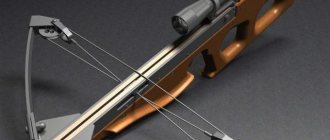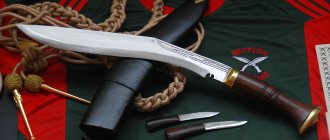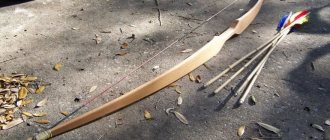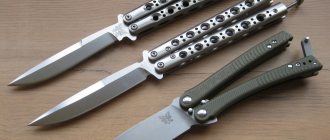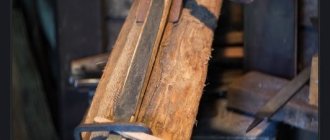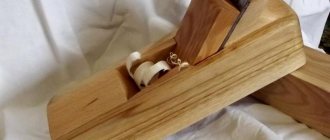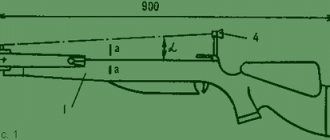Distinctive features of a hunting ax
The item differs from the regular version:
- compactness;
- ergonomics.
Despite these properties, they can easily:
- chop the bones of large animals;
- cut up carcasses.
The length of the device reaches 40 cm, the weight is usually small - up to 750 g. These characteristics are affected by the brand and material of manufacture. Often the product is all-metal and has soft rubber inserts on both sides. Thanks to these inserts, it does not slip out of your hands and cannot cause injury.
Hunting ax with a wooden handle.
Disadvantages of a hunting ax
The disadvantages of the device include:
- the ability of the blade to become dull and break;
- rapid fatigue from an uncomfortable handle;
- lack of professionalism of the manufacturer (who did not take into account the difficulties in hunting);
- hunter's inexperience.
Many fans believe that the item is not particularly necessary due to:
- rare use;
- heavy weight (although the decisive role belongs to this device in an emergency);
- difficulty of acquisition (some types belong to the category of edged weapons);
- non-compact placement among equipment.
Etching is the most important stage in hatchet making
For etching, it is best to use an inverter welding machine at a minimum current (30 A). As an electrolyte, a solution of water (3.5 l) and salt (700-750 g). Before starting work, it is better to check the intensity of etching on any piece of metal.
PHOTO: YouTube.com The electrolyte is ready, the welder is in place, you can start
Connecting elements to welding wires
First of all, a hatchet is attached to the positive cable, which is completely immersed in the electrolyte. But the negative contact needs some work. To increase the area immersed in the electrolyte, you can use a mounting plate for a metal profile. It should be curved so that the contacts are on both sides of the hatchet.
PHOTO: YouTube.com The mounting plate is perfect for etching
Etching procedure, inspection, protection of the welding machine
Having lowered the negative plate into the electrolyte, you need to make sure that both its sides are equidistant from the hatchet. Only after this can the welding machine be turned on. A violent reaction will begin almost instantly. It looks as if the electrolyte is boiling. In fact, this is not far from the truth; electrolysis does its job. Unpainted metal is etched away. No harm is caused to the painted surface; it remains untouched.
Etching is carried out in 5 passes. The welder turns off every 2 minutes to allow it to rest. It turns out that the total etching time is about 10 minutes. After this, the ax can be removed from the electrolyte.
PHOTO: YouTube.comThe electrolyte first boils and then turns dark
After the required time has passed, the hatchet can be removed from the container and the result can be assessed. If the etching depth seems shallow, you can continue. If everything is in order, then it’s time to remove the paint.
PHOTO: YouTube.comIf the etching depth is satisfactory, you can move on to the next stage
The final part of working with metal
The ax needs to be washed off the salt under running water and dried, then remove the paint from it. This can be done with fine sandpaper or acetone. Next, the entire surface must be polished. A felt circle mounted on an emery board or drill is perfect for this purpose. Only after polishing can you fully evaluate what the result of the work done is.
PHOTO: YouTube.com We can say that it turned out very well
Criterias of choice
Before purchasing a tool, you should study all the characteristics in detail. The result of the work directly depends on:
- material quality;
- weight;
- handles;
- dimensions
Materials
The best base for the device is alloy steel, which has high strength. The ax handle for a hunting ax is most often made from this steel. The all-monolithic structure is practically not subject to deformation.
Ax for hunting.
Steel quality
A lot depends on the quality of the steel. Select a type that is not characterized by strong softness or hardness. Soft iron tends to dull quickly. As a result, it will not be possible to use it.
Chips often appear on hard steel.
To test this criterion, you need to hit any metal object.
The appearance of a ringing sound indicates good quality. A dull sound corresponds to low quality steel.
Weight
Most of the products have an impressive weight. Axes are hard to carry and not always convenient. This is one of the main disadvantages. Therefore, it is recommended to purchase models weighing up to 1.2 kg.
The ax should be light and comfortable.
Dimensions
When choosing the appropriate size, they adhere to the anthropometric data and preferences of hunters. Basically, the length varies between 30 – 40 cm. This option is the most functional.
Handle material
The handle can be:
- wooden - from dried and hard wood (birch is an excellent solution in this matter);
- metal - with an overlay that prevents slipping.
Wood for an ax
Any ax consists of a holder, it is called an ax handle, and a blade. Wood is often used to make an ax; it is a convenient and practical material. But not every breed is suitable for this purpose.
An ax is a percussion instrument; when working with it, it is the ax handle that bears colossal loads. What type of wood will the ax holder support? what is it made from? must meet certain requirements.
The wood for the ax must be hard, have high fracture strength, and withstand shock and compression. Most often, hardwood is used to make an ax. The wood for the ax must be well dried; for better drying it is better to use special drying chambers. The drier the material, the better, this will help avoid problems with the ax handle due to changes in humidity.
A very important characteristic that you should pay attention to when choosing wood for an ax handle is the direction of the grain. In order for the ax handle to be strong and withstand impacts well without cracking, the wood fibers must be positioned evenly, without interlacing.
What wood can be used for an ax handle?
The most popular types of wood used for ax handles
- ash. Among all the possible types of wood used to make an ax holder, ash most ideally meets all requirements and has virtually no disadvantages. In terms of its mechanical characteristics, ash is very close to oak. Ash wood is hard, durable, and has a high density, which allows it to withstand heavy impact loads well. Despite this, ash is not so expensive, such wood is available and can be found in any hardware store;
- jatoba. An exotic breed that has won many fans in our country. Jatoba wood has high levels of strength and hardness, which exceed those of oak wood. Moreover, this tree has a very beautiful structure and color; products made from jatoba have a high decorative value. This wood is easy to process and does not require maintenance. It costs quite a bit, considering its foreign origin, but to make an ax you won’t need much of it;
- beech. Beech wood for ax handles has high hardness and is characterized by durability. Despite its high hardness, beech does not cause any difficulties in processing and does not crack. But such wood absorbs water very strongly, which negatively affects the use of the ax;
- oak. Oak wood is the standard of reliability and durability. Indeed, such wood has high hardness, resistance to any load, as well as to moisture, fungi and pests
It looks beautiful and expensive, of course this is not so important when making an ax handle, but still. But oak has considerable weight and, combined with high hardness, creates a strong kickback in the hand when working with an ax;
- birch. This type of wood is not the best option for an ax handle. It takes a very long time to dry and is problematic, has high hygroscopicity and is susceptible to rotting. The hardness of birch can be called low. But more than half of the axes available for sale are equipped with an ax handle made of birch. Why? The answer is simple - the low cost of the material and ease of working with it. With the help of proper processing, the properties of such a material can be significantly improved, and such wood is quite suitable for small household axes;
— maple. Also one of the popular types of wood for making ax handles. Maple is durable, resilient, and easy to process. In addition to good mechanical characteristics, maple also has a beautiful color and soft structure.
Irina Zheleznyak, Staff correspondent of the online publication “AtmWood. Wood-Industrial Bulletin"
How useful was the information for you?
How to convert an ax into a hunting ax
You can make a hunting model from an ordinary ax. In preparation:
- Check the metal head for rust.
- When detected, soak in acetic acid for a day.
- Remove corrosion with a brush.
Algorithm step by step:
- A semicircle is cut out inside the head to improve the girth.
- The front indentation is cut out in the metal part. It is located at the level of the butt. Protrusions of 5 - 7 degrees are removed whenever possible. However, this is not critical.
- Using a grinder, cut off the tip from behind until it becomes rounded. An emery wheel will help with this.
- A semicircle is cut out in the lower area of the head to improve the girth of the object and reduce its weight.
- Make 2 corners of the butt.
- Sharpening the metal head.
Method of making an ax:
- Choose high-quality wood (it is easiest to process and sand pine, birch, ash, maple). The length should be from 50 to 80 cm. In rare cases, up to 120 cm.
- The diameter is at least 14 cm, and the length must exceed the final version by 20 cm.
- The workpiece is thoroughly cleaned. Chop and leave to dry for up to 8 weeks. The workpiece should be located in a room where there is low humidity and the temperature is 22 degrees.
- Process using a chisel (occasionally a hammer). Adhere to a certain shape corresponding to the drawing.
- When assembling, connect both parts. To do this you will need epoxy resin and gauze. Additional fixation can be made using wooden wedges.
- After production, they begin to work within 2 days.
Wood product
A wooden hatchet cannot compare with the work of an iron one
, but sometimes it is very necessary. Thanks to its light weight, it is easy to take on a hike to chop simple branches, and it can also be used as a weapon for training or at home.
How to create this product? The ax handle and head can be made either individually or as a whole structure. The material selected is strong, dry, and fiber-free. It is worth taking oak or maple.
Hunting ax
A hunting tool must have excellent handle balance
to perform the correct shots. It is best to use an all-metal device, because it will reduce the likelihood that the ax handle will fall apart when cutting a carcass or when cutting the bones of an animal. If there is no chance to forge such a product, you can make it yourself from a blade and a wooden axe.
Then you need to harden the iron
. To create an ax handle, a special birch, rowan or elm is used. To find out the correct length of the ax, you need to take it by one end, and the particle with the attachment for the product should touch the ankle. When placing a blade on a part, its end must be wedged for better fixation. After this, an oblique cut is made and a wedge is placed.
It would be great if the wedge was made of the same material as the ax handle. It can be placed on glue, and if the inner part of the butt becomes loose, the problem will be quickly solved if you soak the device in some water. You should not use a metal wedge, as it will begin to rust and damage the wood.
Do-it-yourself ax handle
Drawings will be primarily required to create this product.
This is a very important device that is not difficult to make. In order to make it, you will need:
- Wood blank.
- Knife.
- Carpentry tools.
- Cutting device.
- Pencil.
- File.
- Hammer.
The creation process itself will be performed in a certain order:
- Create a template on paper. The ax of the finished device is placed on the cardboard and outlined with a simple pencil. They cut it out.
- A block is made from dried wood. The particle of the workpiece on which the ax part will be placed must exceed the dimensions of the metal eye by two or three mm.
- The contours of the template are transferred to a wooden blank. You should leave a margin of ten mm at the front, and ninety mm at the rear.
- Cuts are made transversely along the top and bottom of the wooden block, the depth of which is a couple of mm short of the selected contours of the ax handle.
- The fitting of a metal part is carried out using hammer blows. If everything is fine, they clean it.
- The almost finished base is sharpened everywhere with a blade. They try to smooth out the corners and transitions with a file. At the end everything is sanded with sandpaper.
- Using a small hammer, knife and chisel, the workpiece is finished to the required shape. Place a knife in place of the cut and slowly tap it with a hammer. That's it, the ax handle is done.
“Come on, give me back my stone axe” - there is probably no person in our country who has not heard this song. Yes, the first axes were made of stone. But this time passed many thousands of years ago, and now high-quality wood and steel are used to make this product.
During the development of civilization, many varieties of this tool have appeared (construction, throwing, etc.) which have not yet lost their relevance. Moreover, on the market you can find many varieties of this product, which are designed to solve certain problems, for example, those facing a hunter or tourist.
Safety precautions when working with an ax
Careless handling of the product may result in serious injury. A few safety tips:
- the product must be all-metal;
- one hunter is engaged in cutting up the carcass;
- do not walk with the device, holding the ax handle;
- hold the blade away from you, point the ax down;
- An ax with a removable handle is extremely dangerous. It may fly out of the handle;
- the design is not intended to be thrown;
- It is prohibited to use while under the influence of alcohol.
A hunting ax is a convenient and necessary item.
Sharpening rules
The device must have a sharpened blade. A blunt object will not cope with difficulties in the forests. The sharpening has a rounded, steep shape, which is less likely to become dull.
Manual method
You can sharpen it yourself. For this:
- They make the workpiece, taking into account the dimensions. Use a piece of tin and determine the required angle.
- The tool is tried on with a ready-made template.
- If deviations are identified, notes are made.
- Often, coarse, fine-grained sandpaper is used. Glue on top of a wooden block, which is used during the season.
- Sharpen while holding the blade away from you.
Mechanical
You can sharpen it quickly and effortlessly on a special machine. Mechanical method algorithm:
- Place the machine on a hard surface.
- Make marks with a marker to change the angle of the blade if necessary.
- Turn on low speed, hold the blade away from you.
- After completion, you need to lubricate the grinding wheel. Finishing paste is suitable for this.
- The object is polished on a grinding wheel.
- Treated with anti-corrosion agent.
Ax sharpening diagram.
Operation and care
When working with a taiga ax, you must comply with all safety requirements and proper handling of the tool.
The blades should always be kept closed and dried after use, otherwise they will rust and become dull, which significantly reduces the efficiency of cutting and the life of the ax. Always remember that axes are not a toy
They can be reliable helpers in difficult survival conditions, but if handled carelessly and frivolously, they cause their owners a lot of trouble. The ax is intended for cutting down trees - this means that it should not be used for digging the earth or working with materials that can dull it or simply break it. The ax should not be thrown into the ground, as this will cause the blade to deteriorate and rust. You should not put the tool into the fire - this leads to a deterioration in the technical and operational characteristics of the steel.
It is important to check the sharpness of the blade in advance; there should be no chips or burrs on the plate. You cannot start cutting if there are strangers in the work area, especially children.
You cannot start cutting if there are strangers, especially children, in the work area.
When swinging strongly, hold the ax handle as tightly as possible - otherwise the tool may slip out of your hand.
For more information about the features of taiga axes, see the video below.
